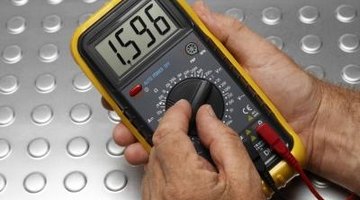How to Calculate the Amps of an Outlet Using a Multimeter
An amp (ampere) is a measure of the amount electrical current passing a specific point in the circuit. You cannot directly measure the amp load of an outlet; that would create a zero-load power source and open the electrical breaker, short the circuit and possibly break your multimeter. In North America, most outlets provide a maximum of 15 amps. In modern construction, builders install 20-amp outlets in kitchens to provide additional power to heating devices.

-
Unplug the device from the outlet. Cut the hot wire for the device with wire cutters. This is the wire with the smaller prong on the plug.
-
Strip 3/8 inches of insulation off the end of both cut wires. Wrap the wire going to the plug around the red probe's tip of the multimeter. Wrap the wire going to the device around the black probe's tip. Wrap the connections in electrical tape so they cannot contact each other.
-
Set the meter's dial to the current (A) setting. Plug the device into the wall outlet and turn on the device.
-
Read the amp draw for the specific device on the meter's display.
Tips
- Do not insert the probes from the multimeter directly into the outlet. You cannot read amps in this manner.
Warnings
- Never touch the live bare wires or put yourself in a situation where it is possible. There is enough power in an electrical outlet to stop your heart.
Writer Bio
Bob White began his writing career in 2006. Working in sales, he was a technical writer tasked with responding to requests for proposal. White has a Bachelor of Arts in computer science and a diploma in home inspection. He has also worked in construction, landscaping and the pool industry for more than 15 years.
Photo Credits
- Polka Dot Images/Polka Dot/Getty Images
More Articles



